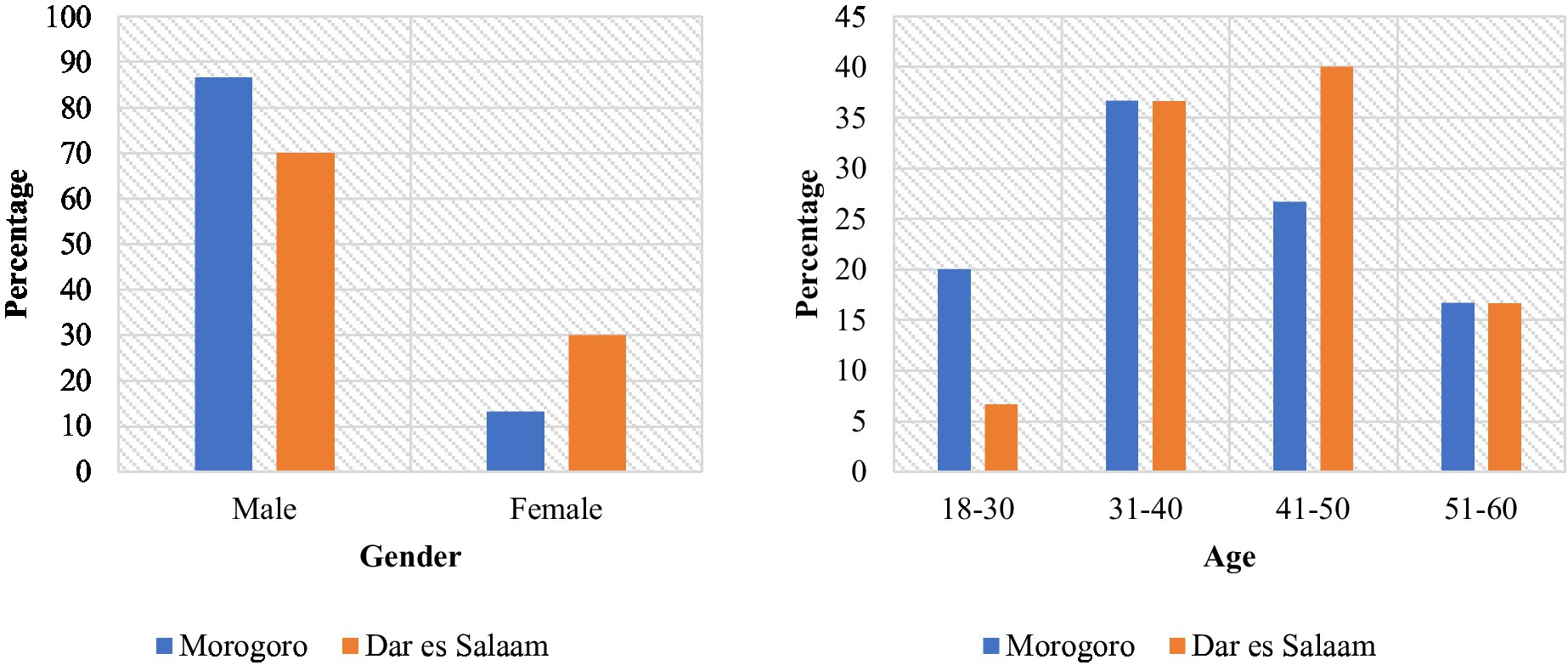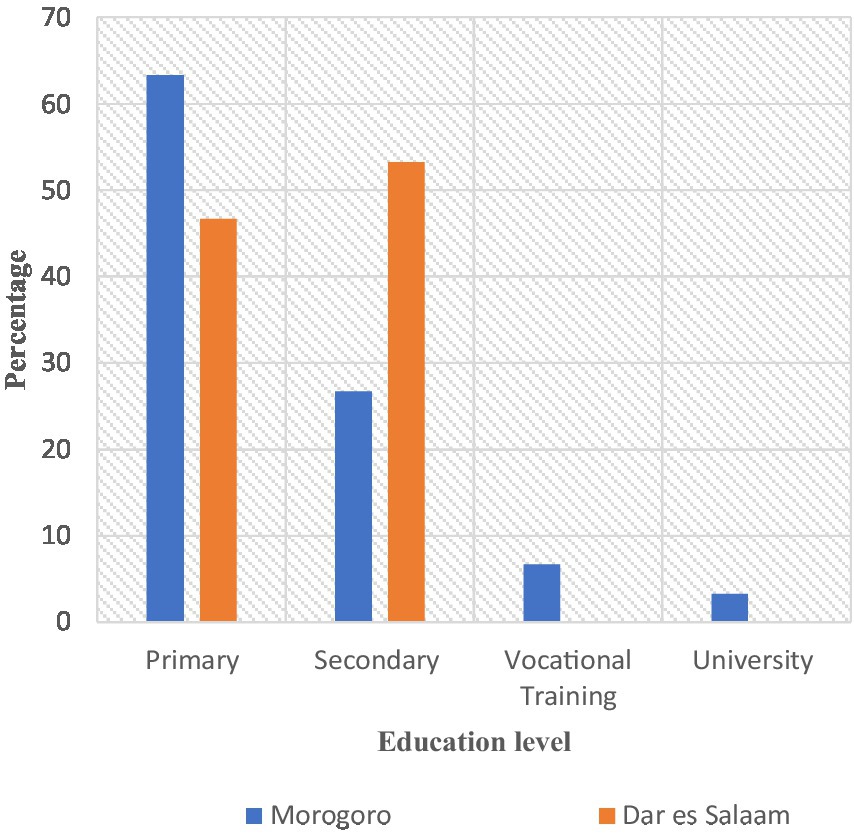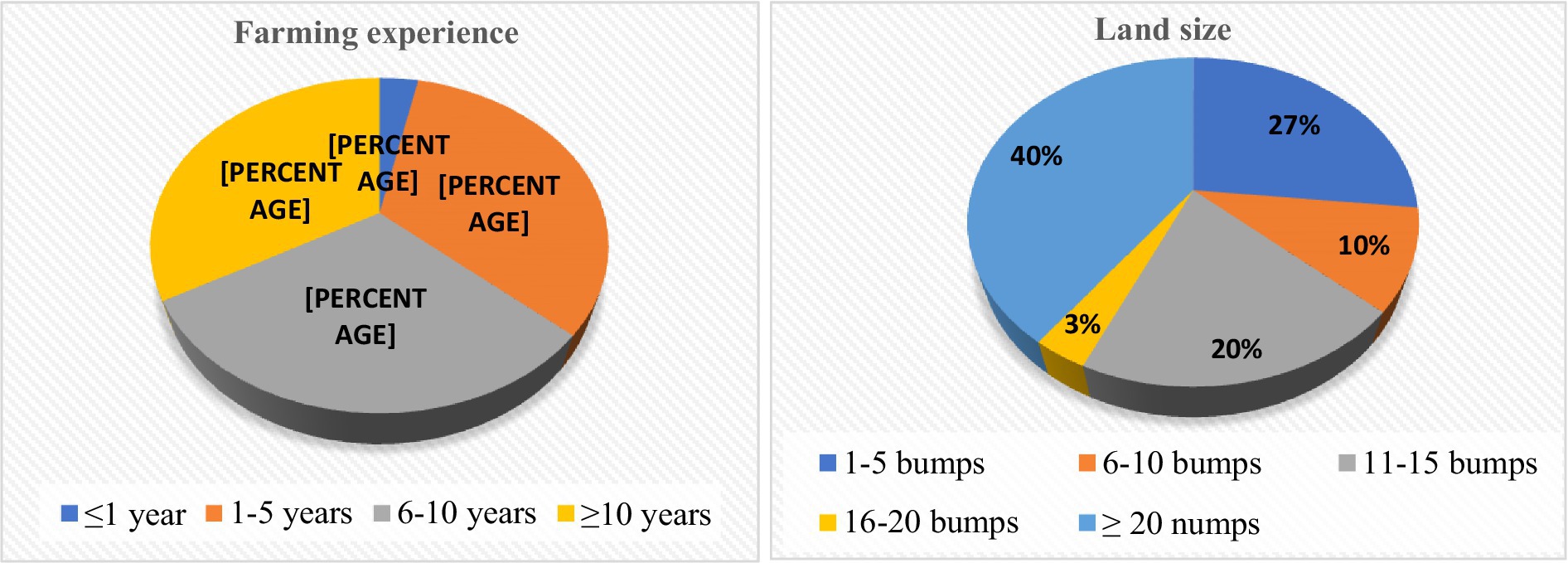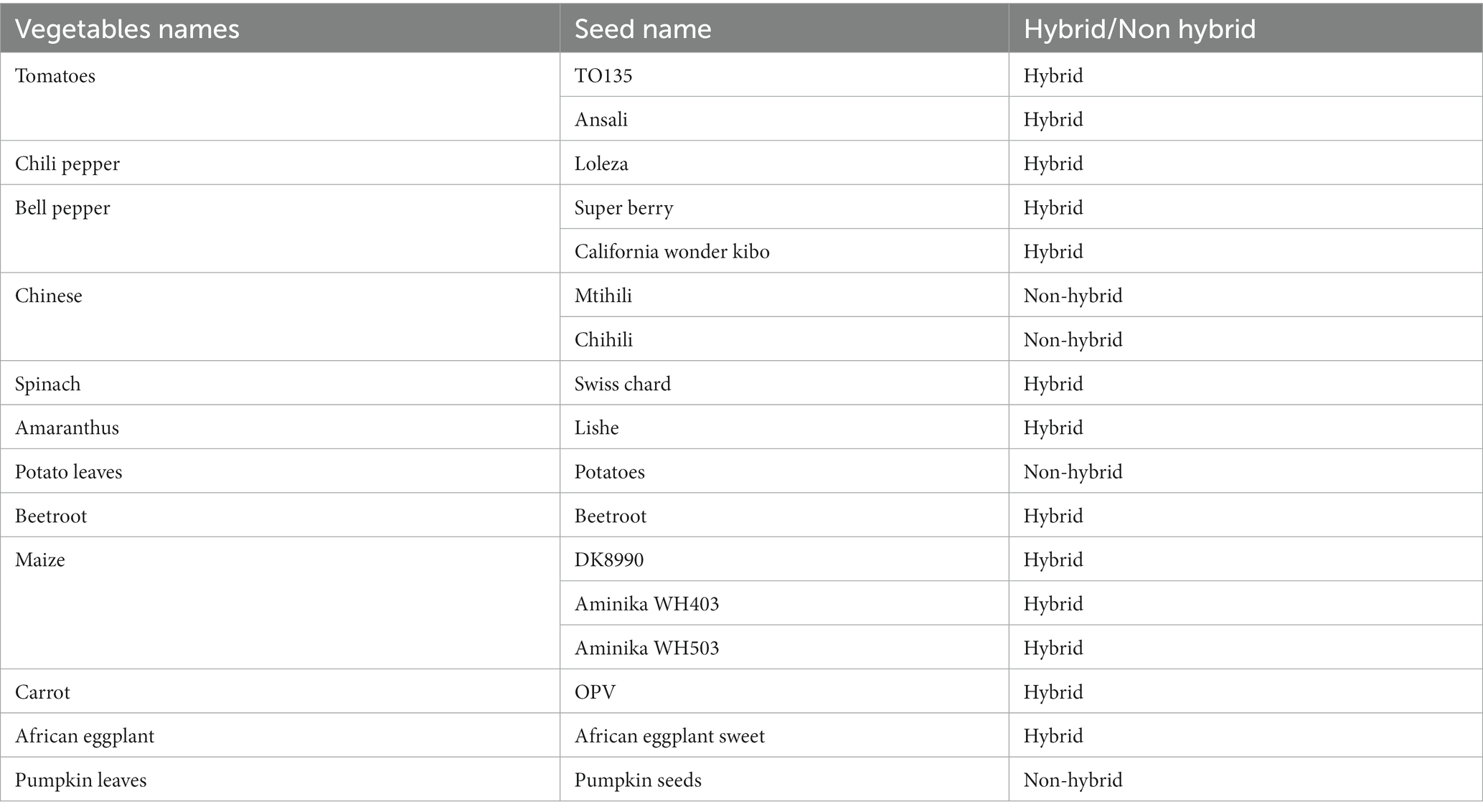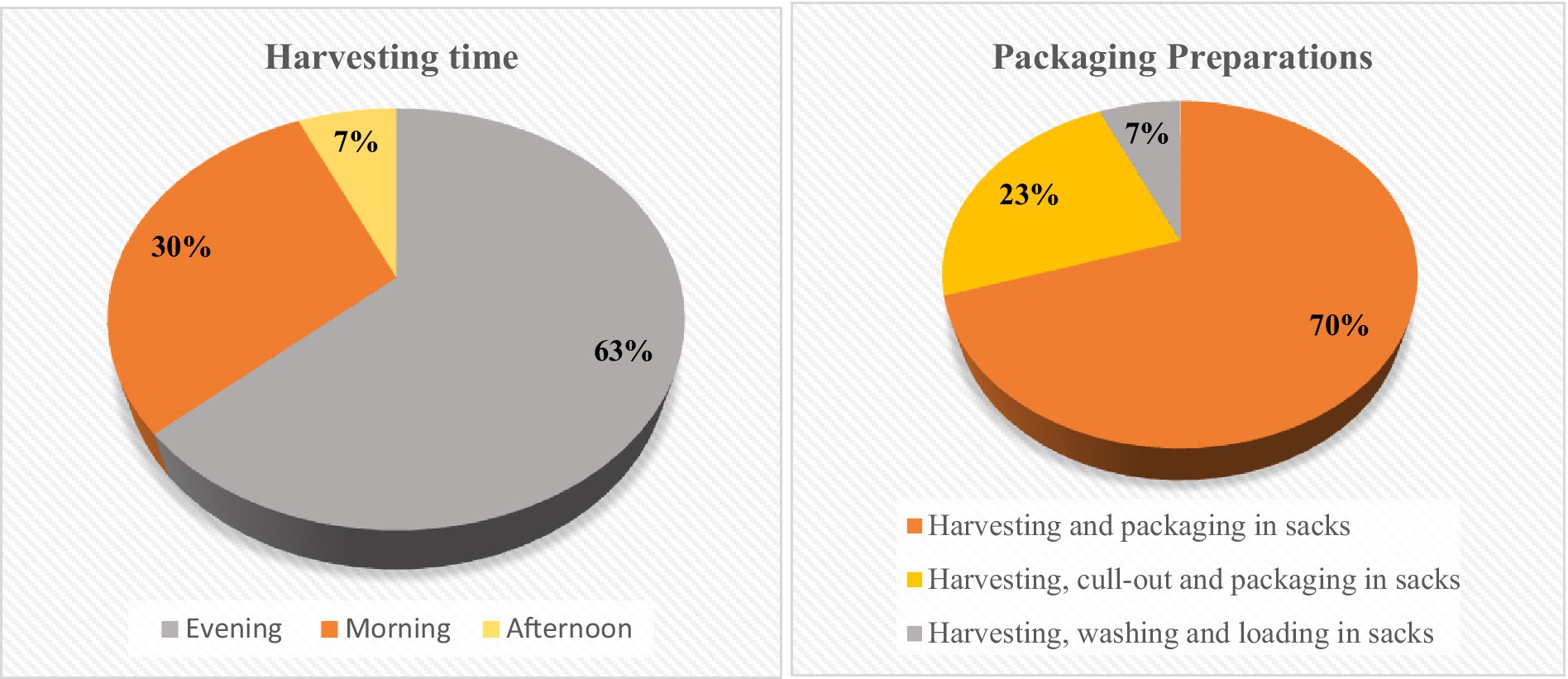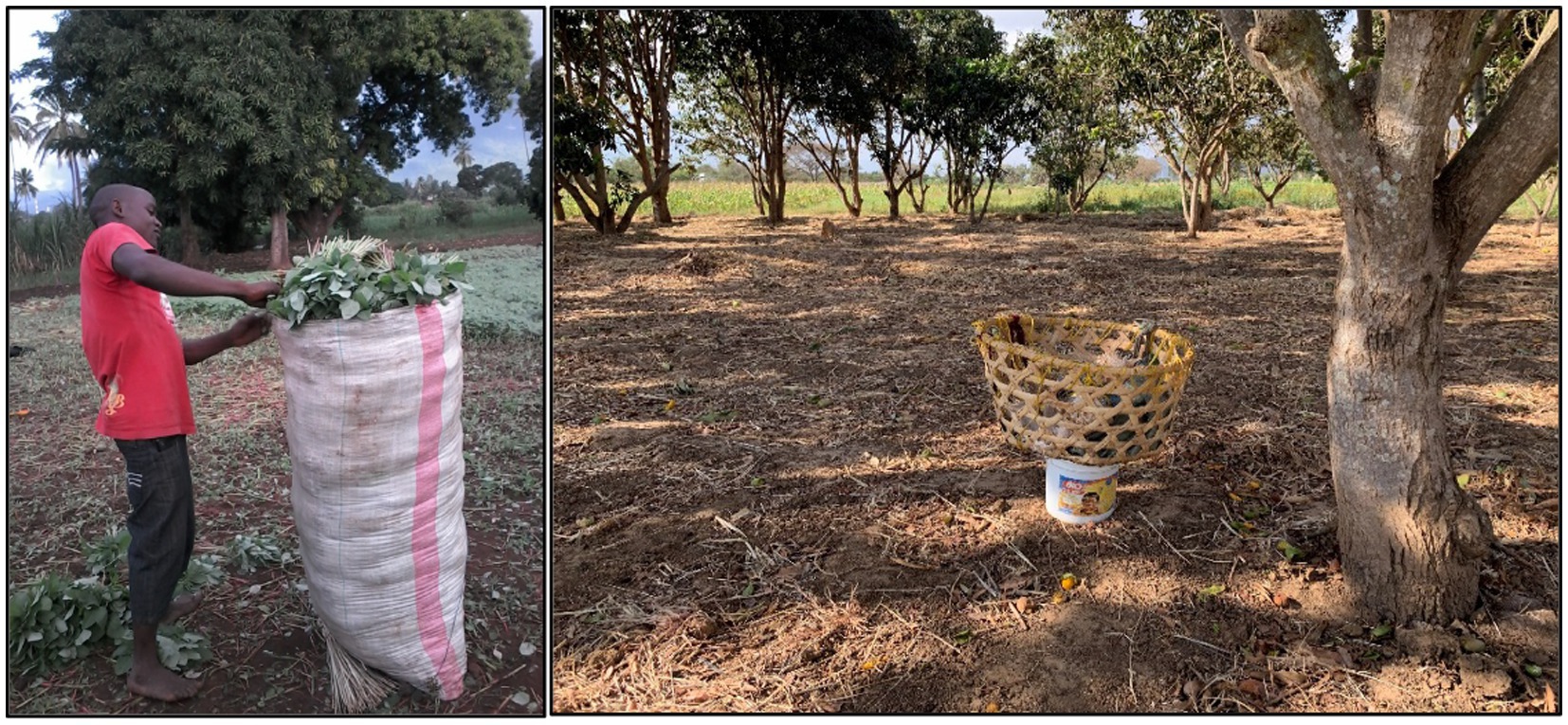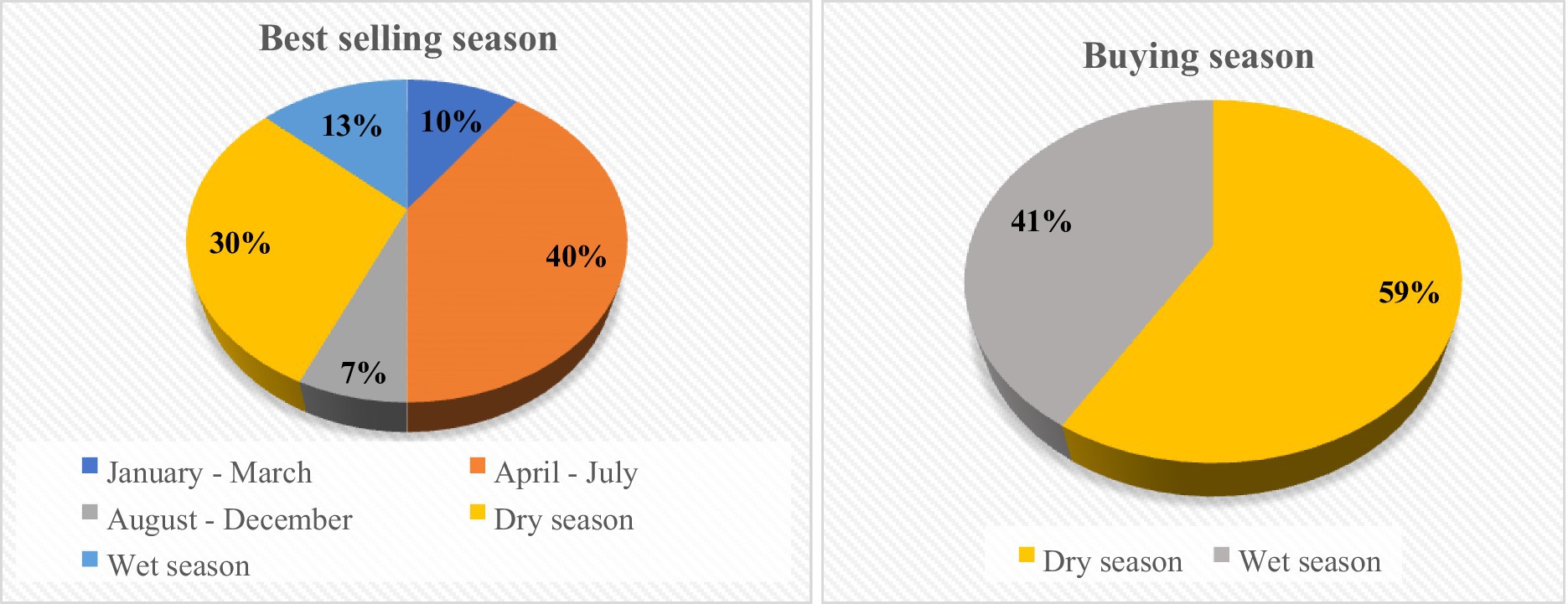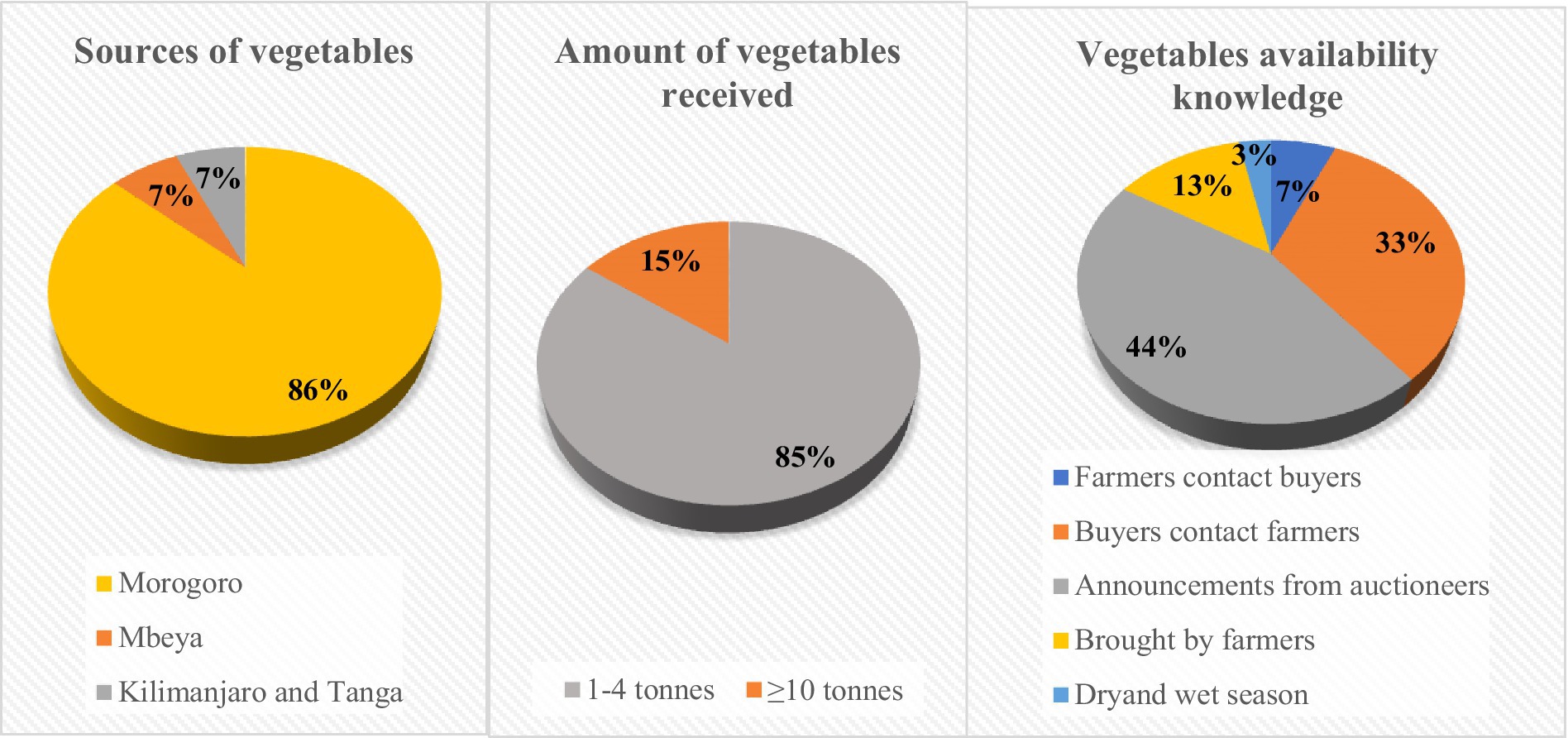Cities’ food synergies: vegetable production and consumption between Morogoro and Dar es salaam, Tanzania
- 1Department of Architecture, School of Architecture Construction Economics and Management, Ardhi University, Dar es Salaam, Tanzania
- 2Department of Social studies, The Open University of Tanzania, Dar es Salaam, Tanzania
The world’s population is fast increasing, leading to rising urbanization and food insecurity. As a result, food synergies between towns nearby are being pursued particular in the Global South in order to alleviate food problems. A study was conducted specifically on vegetable production and supply dynamics focusing one city (Dar es Salaam) and a nearby town Morogoro (200 km apart). A random sample was used to choose 30 purchasers (Dar es Salaam) and 30 vegetable growers (Morogoro). According to the findings, megacities such as Dar es Salaam rely on both neighboring and distant cities for food supplies, however, Morogoro was found to be the main supplier of vegetables in the city where also, Morogoro was more dependent to the high vegetable consumption level and purchasing power that assure the farmers a stable and reliable market in all seasons. In both cities, lack of adequate storage facilities to farmers and to buyers surfaced as a matter of concern. The report concludes that the two cities are extremely dependent on one another in terms of production and consumption. It is recommended that urban farmers be aided in changing traditional vegetable production and processing practices into modern, sustainable, and environmentally friendly practices that will boost productivity and ensure food security in urban areas.
1. Introduction
According to research conducted in North Carolina and Georgia Universities, for the first time in human history, the rate of the population residing in urban areas has surpassed that of rural areas (Orsini et al., 2013). The study further showed that urban population was predicted to be 3.303.992.253 persons, while the rural population was 3.303.866.404 (Ibid). Another observation from FAO has shown that as a result of rural-to-urban migration and natural population growth, urban population growth is more evident in emerging countries (FAO, 2007; FAO-FCIT, 2011). Projections indicated that in 2020, 55% of the world’s population lived in urban centers, and this percentage will rise to 60 and 70% in 2030 and 2050, respectively (Ibid). It is also estimated that across emerging economies and developing countries, an exceptional growth in urban population will be observed (UNFPA, 2007). This urbanization process has a wide range of unintended consequences, including the loss of arable lands, deforestation, air and water pollution, and reduced rainfall drainage, which leads to food insecurity (Baud, 2000). Food security is defined as a situation in which all people have physical, social, and economic access to enough, safe, and nutritious food to meet their dietary needs and food preferences for an active and healthy life at all times (FAO, 2001). Food security, in general, encompasses food supply, physical, social, and economic access, adequacy, use, safety, nutritional value, and cultural acceptability (Jongwe, 2013).
Food dynamics are one of the world’s fastest-growing challenges in the developing world. Thus, interdependence among nearby cities is being called for to solve food difficulties in the face of expanding population, urbanization, and the unraveling impacts of climate change. This is because not all cities are equal or growing in the same direction or rate. Many countries, particularly developing countries, are focused on the need to produce food and feed their rapidly growing population (Idumah et al., 2020). One of the key techniques being spontaneously adopted in both developed and developing nations to address the issue of food insecurity is the growth of Urban and Peri-urban Agriculture (UPA) in general, and urban horticulture in particular. UPA has gained popularity in affluent countries like as Australia, Canada, the United States, England, France, and New Zealand, with gardens found on windowsills, rooftops, basements, walls, recreational areas, and roadsides (Corbould, 2013).
In developing countries such as India, Vietnam, China, Cuba, Ghana, Uganda, and Kenya, urban agriculture plays a larger role in food security. This is particularly true when the country’s rural food production, marketing, and transportation networks are underdeveloped (Argenti, 2000) thus, produce from urban and peri-urban agriculture accounts for a significant portion of total crop production in many of these locations. Around 90% of fresh vegetables consumed in Ghana’s capital are produced within the city. The same is true in Hanoi, Vietnam, where urban and peri-urban agriculture produces 80% of fresh vegetables and 40% of eggs. As a result, improved health conditions allow for more sustained and steady economic growth at both the household and community levels (Orsini et al., 2013). This trend may also be seen in Tanzania, where cities are either unable to sustain themselves in food production or do not have adequate markets for the food produced. The difference trajectories in nearby cities or towns encourage cities to develop food production and consumption synergies (Mapeto, 2014). Dar es Salaam and Morogoro are typical instances of cities that established a production and consumption relationship to address the issues of inequalities in size, population, location, rate of urbanization, and socioeconomic profile.
Hence forth, this study is envisaged to unveil the dynamics of food synergies between the two cities, focusing on the production process, supply chain, challenges and opportunities linked with UPA in Dar es Salaam and Morogoro.
2. Materials and methods
The study was carried out in Dar es Salaam and Morogoro municipality which were purposely chosen due to their different characteristics and interdependence on food security and economic growth. Based on the 2012 Census, Dar es Salaam has a population of approximately 6 million people at a density of 3,133 per km2 (total land cover of 1,393 km2). The future population projections for the city suggests a continued absolute increase in population with the population anticipated to increase to more than 7 million people by 2025 (World Bank, 2016). Further to that, Dar es Salaam is among the ten fastest growing cities in the Word and the third most urbanizing in Africa. The rate of urbanization has jeopardized the green pockets within the city and also has engulfed part of the peri urban land that was earlier depended on for agriculture. As a result, food production including vegetable has a challenge. The city’s major activities include service industry, commercial, fishery, agricultural related, transport, construction, mining, etc., Morogoro municipality has a total area of 540 km2 with a population of 400,000 people whereby in 2016 there was an increase of 3.81% (equivalent to 622,000 people; Dayoub et al., 2019; Sumari et al., 2020). Moreover, the future population projection for the municipality is estimated to rise to 4.54% by 2030 (Sumari et al., 2020). The majority of the population in Morogoro tends to practice different activities including agriculture, commerce, mining, and forestry. Thus, the different trajectories of the two localities are one of the motivational factors to choose them for an in depth understanding.
The study was conducted through a descriptive design which entailed collecting information by administering questionnaires to a sample of individual farmers and buyers. Purposeful sampling was used to select 30 vegetable farmers within Morogoro municipality. Popularity in vegetable cultivation was the main criterion for selection. While in Dar es Salaam a total of 30 questionnaires were administered to vegetable business owners in Kariakoo (the largest market in the city that sells to the entire city). In addition, sites visit and desk-based literature were employed during the study. Data analysis was performed using Microsoft Excel and SPSS. Data, descriptive statistics including frequencies and percentages were used to enhance the discourse of the study.
3. Results and discussion
3.1. Respondents’ demographic characteristics
The survey included farmers and buyers from Morogoro and Dar es Salaam, respectively. The majority of respondents from Morogoro and Dar es Salaam were males (86.7 and 70% respectively). Studies show that there has been a gender imbalance in urban and peri-urban agricultural activities as is observed within this study. This is due to many reasons including financial constraints, lack of access and ownership of land, low education levels and gender responsibilities to mention a few (Flynn, 2001; Lyimo-Macha and Mdoe, 2002; Mntambo, 2012, 2017, 2021; Pedersen, 2015). As for age group, most (36.7%) in Morogoro were within 31–40 years while in Dar es Salaam 40% of the respondents were aged between 41 and 50 years of age as depicted in Figure 1. While in the case of the least (20%) participants in Morogoro aged 51–60 years and 18–30 years (7%) in Dar es Salaam. These results are in line with those in a study done by Mntambo (2017) which again, was contrary to the observation made by Mntambo (2012). The reason for differing is that vegetable production is taking new shape on day to day basis as farmers and buyers are becoming more sophisticated in the entire process.
In terms of education level, 80% of the respondents in Morogoro Municipality had a primary education level while in Dar es Salaam; majority (53%) among the respondents had secondary education. At the same time, only a few number 6.7 and 3.3% among respondents from Morogoro had attained Vocational training and University education, respectively. While none of the respondents from Dar es Salaam had attained tertiary education level (Figure 2). The above findings generally indicate that the practice of the UPA in both localities is based on informal experience and it is taken as a by the way activity. One of the reason could be associate with a lack of government initiatives to recognize the UPA in forms of policy formulation that lead to the lack of motivation among farmers. Another reason why atleast a small percentage of educated people (6.7 and 3.3%) involved in agriculture in Morogoro is that, this region is considered as an agricultural based locality nationally, whereas Dar es Salaam is nationally considered as a commercial based city. In the latter case, many educated people in Dar es Salaam consider agriculture as a job for less educated people, thus many educated ones shying away from the practice. Moreover, people in Dar es Salaam tend to hire more laborers who are less educated to work in the farms while the owners are busy with other commercial or service oriented activities.
3.2. Farming experience and land size in Morogoro
Based on the information from the respondents, 33% of the farmers had between 1 and 5 years of experience in vegetable cultivation. This was followed by those with an experience of 6–10 years (30%) while the remaining 4% had only an experience of less than 1 year. Although the majority of the farmers had high experience in vegetable cultivation, 40% of the respondents had more than 20 bumps equivalent to 1acre land size. This was followed by 27% of the respondents with 1–5 bumps (less than 0.25 of an acre), 20% with 11–15 bumps (0.5 of an acre), 10% with 6–10 bumps (0.25 of an acre) and lastly only 3% had 16–20 bumps equivalent to 0.75 of an acre as shown in Figure 3. These land sizes were also somehow similar to those reported by Jacobi et al. (2000) and Mntambo (2012) in the previous studies. The reason behind the usage of small land sizes although urban and peri-urban agriculture is of paramount importance is mainly due to affordability and availability of land leading to small-scale operations (Howorth et al., 2000). There is also a competition with other land uses in urban areas as explained in a study done by Mlozi et al. (2004) hence, making it impossible for farmers to increase their yields (Halloran and Magid, 2013).
3.3. Vegetables cultivated in Morogoro
Different scholars including Dixon et al. (2009), Ajadi et al. (2011), Odewumi et al. (2013), and Dube et al. (2021) have stated that there is a high dependency between variety of vegetables, type of seed used and customer demand. The dependency can be positive and negative between the three aspects. This trend was also observed by authors during the survey where the types of seed chosen for cultivation highly depended on the customer demand. It was noticed that the preferred seeds were hybrid since they are short-term crops (Table 1). This was mainly due to high demand in the market, high resistance to pests and diseases and tolerant in dry conditions. Poor preservation skills. This was further illustrated by a farmer stating, “I am using hybrid seeds because they take a short period of time to harvest. Also, they are high resistant to pests and diseases and tolerant in dry conditions. These reasons assure me of a high quantity of yields to supply to my customers with good quality” said Joseph from Kingolwira Morogoro.
3.4. Harvesting, packaging preparations, storage, and trading
Usually, vegetables are harvested in the evening; this was further confirmed in this study where 63.3% of the respondents reported harvesting their UPA products in the evening when the temperature has cooled down. Also, farmers spend the evening and night time to pack vegetables ready for transport which is done early next the morning so that the vegetables reach the city while fresh. The remaining 30 and 6.7% reported harvesting early in the morning and afternoon, respectively, as shown in Figure 4. These are mainly farmers who do not send their vegetables to distant markets such as Dar es Salaam, thus, their customers come from within the farming areas. One farmer was quoted saying that “my customers just come from Morogoro area, so, they always get fresh vegetables direct from the farm, no need to worry about refrigeration like those who sent to distant located market” said Aisha, a farmer from Kihonda Morogoro. Another reason that may be associated with the time of harvesting vegetable is lack of facilities to manage post harvesting such as refrigeration that could sustain the freshness of the vegetables for a longer period before reaching the consumers in the city. When a farmer was asked why harvesting late in the evening particularly after sun set, she iterated that “vegetables need to be kept in a cool environment, many customers in Dar es Salaam refuse to buy vegetables which have shrinked. There was one time, the customers refused to take 3 sacks of vegetables since they had started turning yellow because of the weather in Dar es Salaam.” Said Mwanaisha, a farmer from Kingolowira-Morogoro.
Normally, after harvesting farmers tend to practice different preparations before packaging to add value to their products including washing vegetables to remove sand, culling out and finally packaging. Despite having these tendencies, the majority (70%) of the respondents reported harvesting the products and packing them in sacks without any of the mentioned preparations. Lack of the above preparations is caused my several factors including lack of proper facilities where farmers could cut, sort and finally pack the vegetables before transporting them to the city. Another factor is the time when they harvest (late evening), the sun is already set and thus no sufficient light to enable them to make proper preparations before packing. Again, lack of proper preparation is associated by the volume which is harvested by a farmer (number of sacks), that is, it becomes difficult for farmers to have sufficient time to properly prepare the vegetable before transportation. A man was heard saying that “washing about ten to twenty sacks of vegetable requires a lot of time, plus, we do not have sufficient amount of clean water to do so, so what we do, we leave the washing to the buyers. He continue iterating that if you was vegetable, they should be dried before packing in sack, otherwise, if packed wet, they will decay after few hours”-Musa, a farmer in Kihonda area-Morogorogo. Contrarily, 23.3% admitted to culling- out the vegetables and the remaining 6.7% tend to wash their vegetables before packaging as shown in Figure 4. A farmer said that “my customers in Dar es Salaam refuse to receive vegetables which are not cleaned before packing, so, I do all the means to satisfy the customer. I do not want to lose them; it is hard to get trustworthy customers.” Complained Mainuna- a farmer from one of the farms in Morogoro. As for storage, 73.3% of the respondents mentioned storing them in sacks ready for transportation as shown in Figure 5. The small percentage (23%) above that admitted doing proper preparation can be associated with the volume of harvest because this is the group of farmers that sell to the nearby consumers.
It was further observed that 13.3% of the respondents tend to store their products outside (no shelter) whereas 3.3% store in fridges and the remaining 10% tend to store in other places like buckets, and baskets (matenga) as shown in Figure 5. Those who store in baskets said that “vegetables need to be placed in open air or in ventilated contained to keep the fresh for a long time, otherwise, heat and moisture is not good especially if you are targeting a distant market,” said a farmer from Bigwa-Morogoro. Lack of proper storage facilities is again shown here, where only a small number of farmers (3.3%) do use refrigeration method for keeping the vegetable fresh. Although it was noted that most of the farmers are not formally educated, however, it can be seen that they have quite a substantial knowledge of handling the vegetables and the needs of the markets.
It was further revealed that the best-selling season was between April–July (40%). Normally, during this season 43.3% of the respondents collect approximately 50–100 sacks of vegetables each weighing 50-80 kg. Climatically, this is the season when many parts of Tanzania experience rainfall that also causes many low lying areas of Dar es Salaam (including the farmers’ plots) to flood. For that reason, the production of the vegetables in the city is nearly impossible thus dependence on the supply from Morogoro become inevitable.
Also, farmers from Dar es Salaam (58.6%) claimed to buy vegetables from Morogoro during the dry season (Figure 6) when many parts of the city are extremely dried up. Climatically, Morogoro is greener and fertile, where most part of it is covered by forests with fertile soil thus remaining moist in a long period of the year. This is also associated by the level of urbanization between the two cities in which Morogoro is least urbanized when compared with Dar es Salaam. For this reason, Morogoro is favorable for cultivation in both rainy and dry season, which make it a good source of vegetable supply to Dar es Salaam.
3.5. Vegetables supply chain in Dar es Salaam
The study further showed that Dar es Salaam does not solely depend on Morogoro for vegetable supply. This was evidently observed from the respondents where a total of 86.7% received vegetables from Morogoro while the remaining 6.7% were from Mbeya and the remaining 6.7% from Kilimanjaro and Tanga. But still, due to proximity and lack of proper storage facilities Morogoro was reported to be the main supplier for vegetables in Dar es Salaam. Generally, 85% of respondents in Dar es Salaam receive a total of 1–4 tons and 15% receive more than 10 tons (Figure 7). “A buyer confirmed that “obtaining vegetables Morogoro is cheap in transportation, reliable throughout, well established for a long time and available in varieties,” said Juma from Kariakoo market-Dar es Salaam.
The food supply and consumption between the two cities has created a social relationship and a trust among the farmers and large scale buyers in such a way that overtime, 43.3% of the buyers tend to be notified by auctioneers on vegetable availability in Morogoro. One buyer confirmed that “I have many middlemen who always call me when the harvesting season come, not only that but they also help me to identify good farmers whose vegetables are safe and well prepared. From time to time, these middlemen keep on calling to notify when the vegetable prices are low in Morogoro,” said Shabani from Kariakoo-Dar es Salaam. Where also, 33.3% of the buyers directly contact farmers for supply and 6.7% of the consumers are called by the farmers to collect vegetables due to their stable relationship on vegetable trading. Another buyer said that “in the past I would incur a lot of money any time to go all the way to Morogoro to fetch vegetables from the farmers, these days I just call the farmers whom I have identified to have good practice to pack and send the vegetable direct from the farms to Dar es Salaam, hence reducing the running cost and time,” iterated a dealer (Karim) in Kariakoo market. At the same time, 13.3% of the buyers reported that farmers tend to bring their vegetables in Dar es Salaam in search of markets. Another dealer reported that “in the past, I have to pay money in cash in order to buy the vegetables, nowadays, farmers trust me, they leave their vegetables here, I sell and sent them money after selling and deducting my profit. This has been a good deal between my business and the farmers; we all gain because of the trust.” Said Juma Hamis- Karikaoo Dar es Salaam.
The above relationship demonstrates the interdependence between the two places (Morogoro and Dar es Salaam) in terms of food production and consumption. Many factors are behind this symbiotic relationship where, Dar es Salaam, due to its economic muscles, has a high purchasing power as compared to Morogoro. Again, there is a huge trajectory difference between the populations of the two regions as noted in the previous section. Moreover, Morogoro has more land for cultivation and its soil is naturally fertile as compared to that of Dar es Salaam. Furthermore, Dar es Salaam is nearly lying at sea level where, during the rainy season, many low-lying areas where farmers grow vegetables undergo flooding. During this time, the city depends totally on vegetable supplies from other nearby regions. Thus, the symbiosis between the two areas can be termed economic, social and environmental.
3.6. Mode of vegetable transportation
The majority of the respondents (80 and 60%) from Morogoro and Dar es Salaam, respectively, explained that vegetables are transported by heavy trucks passing by the farms from different parts of the country due to the strategic location of Morogoro region standing out as a junction connecting nearly the north, south, east and central regions of Tanzania. Thus, trucks passing by this place are used by farmers to transport food to other regions, particularly Dar es Salam where demand is always high. Farmers and buyers agree on the modalities to pay transport costs where the arrangement is that the buyers (64% for Dar es Salaam and 50% for Morogoro) pay transportation costs. Both farmers and buyers confirmed in different occasions that they have established a stable relationships with the truck drivers to transport the vegetables. A buyer iterated that “I have a number of truck drivers who pass at Morogoro from the countryside; they normally inform me whether I need some vegetables from Morogoro, and then, I connect them with the farmers who prepare the vegetables in advance ready for transportation. I pay the farmers through a mobile money system. It has been convenient these days,” said Abdallah from Kariakoo-Dar es Salaam. In the same accord, a farmer was quoted saying that “You know what, truck drivers have taken most of our mobile numbers, before reaching Morogoro from other places, they call us asking whether we have vegetable sacks to send to Dar es Salaam, some of us take that advantage as long as we also communicate with our buyers in Dar es Salaam. I save plenty of time instead of travelling all the way to send vegetables to Dar es Salaam” I use that time to work in my farm and take care of the family, iterated Mariam from Kihonda-Morogoro.
3.7. Challenges and opportunities
The study shows that vegetable business owners are also faced with different challenges including lack of assured market, low demand, high price, scarcity of vegetables, transportation delays, low vegetable quality, rotting of vegetables, presence of auctioneers and lack of proper storage facilities. “A farmer recapitulated that this business is good, however, we face a number of challenges in the making, so, we need have a more formal system that will protect us against those challenges. For instance, we need to have an organized system of farmers that will protect our interest and that will help us speak one voice to the government and buyers,” said Mrisho from Kingolowira Morogoro. It was observed that the lack of proper storage facilities in Dar es Salaam markets is higher (40%) compared to Morogoro (10%). Also, this trend was observed in the study where it shows that about 20% of the vegetable traders in Morogoro had their vegetable rotting before reaching the customers while 30% were from Dar es Salaam due to distance and the weather conditions of the two regions. “There was time I received about ten sacks of vegetables all rotten on the way because the track got problem on the way, supposed that truck would have refrigeration system, do you think we would get such a big loss”? Bitterly, complained one of the buyers in Dar es Salaam. Dar es Salaam is warmer compared to Morogoro region (including Morogoro Municipality). Understanding this, farmers consider sacks more suitable for storing vegetables in Morogoro while they also acknowledge the sacks unsuitable for Dar es Salaam due to the high temperatures and humidity. This place is warm and humid, farmers who wants to bring their vegetable here have to know that and find a suitable system to ensure that the vegetables reach the market with freshness, otherwise, our clients will not buy the vegetables if they are shrunk,” said Musa from Kariakoo Dar es Salaam. Furthermore, the study entails that farmers (Morogoro) are highly (20%) affected by auctioneers who act as middlemen between the farmers and the buyers compared to those from Dar es Salaam (13%). This is because some of the farmers in Morogoro depend on middlemen to connect them with buyers in Dar es Salaam leaving the farmers with no other option but to accept the price given by the middlemen, which is a better option than leaving the vegetables to rot in the farms. One women complained, “these middlemen sometimes do not say the truth in relation to the vegetable prices in Dar es Salaam. Sometime they give us low price arguing that there is plenty of supply in Dar es Salaam, which, sometimes is not true. So, we end up getting a low price,” Halima from Bigwa in Morogoro.
3.8. Economic gains in production
Results from this study show that 70% of the respondents from Morogoro seasonally earn between 1,000,000-5,000,000TShs (1 USD equivalent to 2,335 Tshs) as an average profit and 30% earn 500,000-1,000,000TShs. Whereas for the case of Dar es Salaam, 70% earn less than 500,000TShs; 27% receive 500,000-1,000,000TShs and the remaining 3% get more than 10,000,000TShs. Two farmers were heard expressing their satisfaction by saying that “the amount I get here is somehow better that someone who is employed in the government formal system depending on the monthly salary, I am able to meet all my family needs through this business, and if I get more training and skills, then I am can do far much better even than the graduates, she said while laughing.” In a different account, another farmer was hear saying that, “through this business, I have been able to meet my needs such as paying for three children school fees, attending my daily needs including medical care and living a better life, I cannot complained much,” said Mpongo from Morogoro.
There are different reasons why the income from vegetable cultivation differs from one business owner (both farmers and buyers) to another. These may include plot size, experience in vegetable cultivation (including the established social relationships, networks between a farmer and the buyers), and the number of buyers to mention a few for the farmers. “You see here, I get about thirty sacks per harvest, this is just a small amount of land, if I could get more land, I think I could do better even become rich through the same business,” iterated Abdallah-Morogoro. In some cases, a buyer may consider the number of days of working on the farm, dependency of more than one source to buy vegetables (region) and the number of customers to sell in retails to determine whether the business pays or not. Studies done by Jacobi (1996) and Mntambo (2012) explained that most vegetable growers are unaware of the profits they attain from it due to poor record keeping. The previous studies’ observation differs from what was observed in this study where both farmers and buyers are well aware of their profits seasonally. This shows that over the years both vegetable growers and buyers are becoming well informed on how their businesses are useful in sustaining their lives by keeping records. “Sometimes ago, an extension officers visited us, they gave us knowledge and advantage of having farmers diaries where we keep all the record of farm inputs and other records, through these, we able to establish how our business are moving,” said a farmer in Kihonda Morogoro. This is evidence that in recent times, both farmers and buyers are modernizing their systems of documentation and record keeping where they can account for both inputs and outputs.
3.9. Policy implication of the study
This study was set to investigate the food synergies among the two study areas in terms of vegetable production and consumption. The study has contributed knowledge pertaining to broader implications of urban agriculture and food security in rapidly urbanizing areas of the global South where it is further found that vegetable production can contribute to the availability and accessibility particularly fresh vegetables. It can also be agreed that for urban poor, this is a good source of food, employment, and income as well as social networking among the groups involved in. The findings obtained in this study are in line with another study done in the previous years by other scholars (Cohen and Garrett, 2010; Mougeot, 2011) who also demonstrated the potentials of vegetable production and consumption in urban areas.
This study noted the importance of promoting fresh, local foods that have a lower carbon footprint than food grown far from the city as well as illustrating urban agriculture as a practice of sustainable food systems. This idea is comparable to the conclusions in the IPCC report (2019) that advocates for the potential of local food systems to increase environmental sustainability and reduce green gas emissions. Moreover, Smit et al. (1996) and Rosol et al. (2011) emphasize similar findings when discussing the potential of urban agriculture to contribute to sustainable urban development. It can thus be agreed that the findings from this study interlink with the results from many other previous observations, which shows the relevance of understanding the importance of urban farming to multi-dimensional aspects to urban dwellers. The findings can be maximized to and applied in various scenarios.
According to FAO (2018) research, farmers can be helped with access to capital, training on sustainable agriculture methods including marketing, distribution, and storage logistics in order to empower the urban farmers. This type of strategy can aid to increase food security, environmental sustainability, and local economic growth and development. The study further sees the potentials of policymakers to encourage the production and consumption of local foods by establishing farmer’s markets, community supported agricultural programs, and food centers that connect local farmers and immediate consumers in order to reduce greenhouse gas emissions and promote community development.
Furthermore, in order to boost urban farming, the study envisions promoting land use planning objectives that set aside space for urban agriculture, green belts, and green pockets that are integrated with community management. Also, authorities can include urban agriculture in urban planning and development by setting aside land for agricultural use and creating green spaces that support food production. This can be accomplished with the help of policies that encourage the creation of community gardens, rooftop gardens, and other types of urban agriculture (McMichael, 2016). Such regulations can help to build resilient and long-lasting urban ecosystems that support community growth, environmental sustainability, and food security in urban communities.
4. Conclusion and recommendation
This study was envisaged to investigate the dynamics of food synergies between two localities named Morogoro and Dar es Salaam, Tanzania. The study revealed a number of things based on the analysis. It was found that the two cities have demonstrated good synergies in terms of interdependency where, one city (Morogoro) due to its climatic parameters, size, and nature of soil, history, low level of urbanization and low economy and population density has been producing and supplying vegetables to the city of Dar es Salaam. On the other hand, Dar es Salaam due to its limited green pockets due to the pace of urbanization, its economic and food consumption pattern, as well as size in population has been acting as ‘market’ consuming the vegetables from other regions particularly from Morogoro.
It was further noted that farmers and buyers of the vegetable from the two cities have varying levels of education, experiences of working in farming and buying vegetables, where, due to these, farmers and traders apply more intuitive knowledge and skills to produce and trade among themselves in lieu of formal trained knowledge. This observation calls for the need of extension officers to work close to the farmers and traders in order to equip the farmers and traders with the knowledge and skills that will enhance the production and consumption of the vegetables between the two localities. In line with the above, it was observed that farmers and traders both lack important facilities such as refrigeration, storage facilities, clean water and washing facilities, assurance of organized systems of transport and market in such a way that they experience loss of business from time to time, which limits their growth.
Although this study used a small sample size, however, the above observations have revealed a number of issues that need the government intervention such as formulation a policy to recognize this important undertaking that plays a crucial role in meeting the food security to both farmers and consumers. Therefore, the study recommends that there is a need to for the government or other institution to formulate systems that will help both farmers and buyers in transforming the practice of traditional vegetable production and processing into sustainable and environmental friendly in order to increase UPA product value.
Data availability statement
The original contributions presented in the study are included in the article/supplementary material, further inquiries can be directed to the corresponding author.
Ethics statement
Written informed consent was obtained from the individual(s) for the publication of any potentially identifiable images or data included in this article.
Author contributions
SO: formulation of the research, planning and execution, corresponding, data analysis, data collection in Dar es Salaam. BM: data collection in Morogoro. MM: writing and analysis. All authors listed have made a substantial, direct, and intellectual contribution to the work and approved it for publication.
Funding
This work was supported by British Academy, Grant no: UWB190091.
Acknowledgments
This paper derives from the project titled “Urban and Peri-urban Agriculture as Green Infrastructure: Implications on Well-being and Sustainability in the Global South (Tanzania and India)”. The opinions and interpretations presented in this paper are from the authors.
Conflict of interest
The authors declare that the research was conducted in the absence of any commercial or financial relationships that could be construed as a potential conflict of interest.
Publisher’s note
All claims expressed in this article are solely those of the authors and do not necessarily represent those of their affiliated organizations, or those of the publisher, the editors and the reviewers. Any product that may be evaluated in this article, or claim that may be made by its manufacturer, is not guaranteed or endorsed by the publisher.
References
Ajadi, B. S., Adeniyi, A., and Afolabi, M. T. (2011). Impact of climate on urban agriculture: case study of Ilorin City, Nigeria. Glob. J. Hum. Soc. Sci. 11, 25–30. doi: 10.1186/s40066-015-0048-y
Argenti, O., (2000). Achieving urban food and nutrition security in the developing world feeding the cities: food supply and distribution Washington, D.C.: International Food Policy Research Institute.
Baud, I.. (2000). Collective action, enablement, and partnership: issues in urban development Available at: http://www.ucl.ac.uk/dpu-projects/drivers_urb_change/urb_governance/pdf_partic_proc/IHS_Baud_collective_action.pdf (Accessed August 16, 2022).
Cohen, N., and Garrett, J. (2010). The food system and urbanization: driving forces, patterns, and implications. Dev. Policy Rev. 28, 657–676.
Corbould, C. (2013). Feeding the cities: is urban agriculture the future of food security? Future Direct. Int., 1–7.
Dayoub, M., Thonglor, O., and Korpela, T., (2019). “Trends of precipitation and temperature in Morogoro region in Tanzania.” Proceeding of the 8th international conference on integration of science and Technology for Sustainable Development (8th ICIST) in November 19–22 at Huiyuan International hotel, Jingde, Anhui Province, P.R. China.
Dixon, J. M., Kelly, C., Donati, J., Pike, L. L., and Hattersley, L. (2009). Functional foods and urban agriculture: two responses to climate change-related food insecurity. NSW Public Health Bull. 20, 14–18. doi: 10.1071/NB08044
Dube, T., Sibanda, S., and Chiwara, P. (2021). Adapting peri-urban agriculture to climate change in Bulawayo, Zimbabwe: a qualitative assessment. Cog. Soc. Sci. 7, 1–16. doi: 10.1080/23311886.2021.1944486
FAO (2001) Urban and peri-urban agriculture. A briefing guide for the successful implementation of urban and peri-urban agriculture in developing countries and countries of transition. Special Programme for food security (SPFS) Rome: FAO.
FAO (2007) Profitability and sustainability of urban and peri-urban agriculture. Agricultural management, marketing and finance occasional paper no. 19 Rome: FAO.
FAO. (2018). Food systems and greenhouse gas emissions. Available at: http://www.fao.org/3/I8011EN/i8011en.pdf (Accessed August 16, 2022).
Flynn, K. C. (2001). Urban agriculture in Mwanza, Tanzania. J. Int. Afr. Inst. 71, 666–691. doi: 10.3366/afr.2001.71.4.666
Halloran, A., and Magid, J. (2013). Planning the unplanned: incorporating agriculture as an urban land use into the Dar Es Salaam master plan and beyond. Environ. Urban. 25, 541–558. doi: 10.1177/0956247813500903
Howorth, C., Convery, I., and O’Keefe, P. (2000). Gardening to reduce Hazard urban agriculture in Tanzania. Land Degrad. Dev. 12, 285–291. doi: 10.1002/ldr.441
Idumah, F. O., Awe, F., and Owombo, P. O. (2020). Factors influencing farm output and income among agroforestry farmers of the fringe communities of Sapoba Forest reserve, Edo state Nigeria Tanzania. J. Agric. Sci. 19, 107–115.
IPCC. (2019). Climate change and land: An IPCC special report on climate change, desertification, land degradation, sustainable land management, food security, and greenhouse gas fluxes in terrestrial ecosystems. Available at: https://www.ipcc.ch/srccl/ (Accessed May 1, 2022).
Jacobi, P. (1996). Economy of Amaranthus spp (mchicha) grown on open spaces in Dar Es Salaam. Dar es Salaam: Urban Vegetable Promotion Project, Ministry of Agriculture and Cooperatives.
Jacobi, P., Amend, J., and Kiango, S. (2000). “Urban agriculture in Dar Es Salaam: providing an indispensable part of the diet. City case study Dar Es Salaam” in Growing cities, growing food: Urban agriculture on the policy agenda. A reader on urban agriculture. eds. N. Bakker, M. Dubbeling, S. Gundel, U. Sabel-Koschella, and H. De Zeeuw (Germany: Food and Agriculture Development Centre).
Jongwe, A. (2013). Synergies between urban agriculture and urban household food security in Gweru City, Zimbabwe. J. Dev. Agric. Econ. 6, 59–66. doi: 10.5897/JDAE
Lyimo-Macha, J., and Mdoe, N.. (2002). Gender and rural poverty in Tanzania: case of selected villages in Morogoro rural and Kilosa districts. LADDER working paper No 18.
Mapeto, T. (2014). Synergy between city household food security and agriculture in Gweru City, Zimbabwe. Adv. Food Sci. Technol. 2, 232–238.
Mcmichael, P. (2016). Food regime for thought, Journal of Peasant Studies 43, 648–670. Cornell University. doi: 10.1080/03066150.2016.1143816
Mlozi, M., Foeken, D., and Sofer, M. (2004). Urban agriculture in Tanzania: issues of sustainability. African Studies Centre, Research Report 75/2004.
Mntambo, B. D. (2012). Women in urban agriculture: are the policies supportive? The case of Morogoro municipality, Tanzania. Huria. J. Open Univ. Tanzania XI, 98–110.
Mntambo, B. D., (2017). “Intra-household gender relations and urban agriculture: The case of vegetable cultivation in Morogoro municipality, Tanzania.” PhD thesis, School of International Development, University of East Anglia, UK.
Mntambo, B. D. (2021). How does gardening activities fit into the lives and gendered responsibilities of women? The case of vegetable cultivation in Morogoro municipality, Tanzania. J. Educ. Human. Sci. 10, 53–68.
Mougeot, L. J. A. (2011). Growing better cities: Urban agriculture for sustainable development. Ottawa: IDRC.
Odewumi, S. G., Awoyemi, O. K., Iwara, A. I., and Ogundele, F. O. (2013). Farmer’s perception on the effect of climate change and variation on urban agriculture in Ibadan Metropolis, South-Western Nigeria. J. Geogr. Region. Plan. 6, 209–217. doi: 10.5897/JGRP2013.0370
Orsini, F., Kahane, R., Nono-Womdim, R., and Gianquinto, G., (2013). “Urban agriculture in the developing world: a review. Agronomy for sustainable development ”, Dordrecht: Springer Verlag/EDP Sciences/INRA, 695–720.
Pedersen, R. H. (2015). A less gendered access to land? The impact of Tanzania’s new wave of land reform. Dev. Policy Rev. 33, 415–432. doi: 10.1111/dpr.12121
Rosol, M., Jezierska-Thöle, A., and Roguska, J. (2011). The potential of urban agriculture in the context of urbanization and climate change in developing countries. Land Use Policy 28, 577–590.
Smit, J., Ratta, A., and Nasr, J. (1996). Urban agriculture: food, jobs and sustainable cities. New York: The Urban Agriculture Network.
Sumari, N. S., Cobbinah, P. B., Ujoh, F., and Xu, G. (2020). On the absurdity of rapid urbanization: spatio-temporal analysis of land-use changes in Morogoro, Tanzania. Cities 107:102876. doi: 10.1016/j.cities.2020.102876
UNFPA (2007) State of world population 2007: Unleashing the potential of urban growth. New York: United Nations Population Fund (UNFPA).
Keywords: food insecurity, food synergies, production, consumption, agriculture, food security
Citation: Ombeni S, Mntambo B and Millinga M (2023) Cities’ food synergies: vegetable production and consumption between Morogoro and Dar es salaam, Tanzania. Front. Sustain. Food Syst. 7:1168883. doi: 10.3389/fsufs.2023.1168883
Edited by:
Chris Duvall, University of New Mexico, United StatesReviewed by:
Mohammad Reza Khalilnezhad, University of Birjand, IranJinghong Zhang, Southern University of Science and Technology, China
Copyright © 2023 Ombeni, Mntambo and Millinga. This is an open-access article distributed under the terms of the Creative Commons Attribution License (CC BY). The use, distribution or reproduction in other forums is permitted, provided the original author(s) and the copyright owner(s) are credited and that the original publication in this journal is cited, in accordance with accepted academic practice. No use, distribution or reproduction is permitted which does not comply with these terms.
*Correspondence: Swai Ombeni, swaiarcht@gmail.com
 Swai Ombeni
Swai Ombeni Betty Mntambo2
Betty Mntambo2 